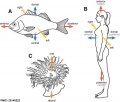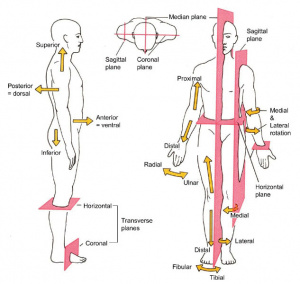File:Anatomical axes comparison.jpg: Difference between revisions
| Line 6: | Line 6: | ||
Designated in a diversity of species and their representation in Biological Spatial Ontology (BSPO). In fishes (A) and in humans (B), ‘anterior-posterior axis’ (narrow synonym ‘rostral-caudal axis’ in humans) is shown in red, ‘dorsal-ventral axis’ (narrow synonym ‘anterior-posterior axis’ in humans) shown in blue, and ‘left-right axis’ shown in yellow. A cnidarian (sea anemone) (C) is bilaterally symmetrical and has an ‘oral-aboral axis’, shown in orange. | Designated in a diversity of species and their representation in Biological Spatial Ontology (BSPO). In fishes (A) and in humans (B), ‘anterior-posterior axis’ (narrow synonym ‘rostral-caudal axis’ in humans) is shown in red, ‘dorsal-ventral axis’ (narrow synonym ‘anterior-posterior axis’ in humans) shown in blue, and ‘left-right axis’ shown in yellow. A cnidarian (sea anemone) (C) is bilaterally symmetrical and has an ‘oral-aboral axis’, shown in orange. | ||
<br> | |||
{{Axes Links}} | |||
===Reference=== | ===Reference=== | ||
Latest revision as of 11:57, 18 January 2019
Comparison of Primary Organismal Axes
K12 - this cartoon shows how different animals have different terms used to describe their body plan axes.
Designated in a diversity of species and their representation in Biological Spatial Ontology (BSPO). In fishes (A) and in humans (B), ‘anterior-posterior axis’ (narrow synonym ‘rostral-caudal axis’ in humans) is shown in red, ‘dorsal-ventral axis’ (narrow synonym ‘anterior-posterior axis’ in humans) shown in blue, and ‘left-right axis’ shown in yellow. A cnidarian (sea anemone) (C) is bilaterally symmetrical and has an ‘oral-aboral axis’, shown in orange.
| Axes Formation: left-right axis | dorso-ventral axis | rostro-caudal axis | limb axis | Coronal | Sagittal | Transverse |
Reference
Dahdul WM, Cui H, Mabee PM, Mungall CJ, Osumi-Sutherland D, Walls RL & Haendel MA. (2014). Nose to tail, roots to shoots: spatial descriptors for phenotypic diversity in the Biological Spatial Ontology. J Biomed Semantics , 5, 34. PMID: 25140222 DOI.
Copyright
© 2014 Dahdul et al.; licensee BioMed Central Ltd. This is an Open Access article distributed under the terms of the Creative Commons Attribution License (http://creativecommons.org/licenses/by/2.0), which permits unrestricted use, distribution, and reproduction in any medium, provided the original work is properly credited. The Creative Commons Public Domain Dedication waiver (http://creativecommons.org/publicdomain/zero/1.0/) applies to the data made available in this article, unless otherwise stated.
Cite this page: Hill, M.A. (2024, April 25) Embryology Anatomical axes comparison.jpg. Retrieved from https://embryology.med.unsw.edu.au/embryology/index.php/File:Anatomical_axes_comparison.jpg
- © Dr Mark Hill 2024, UNSW Embryology ISBN: 978 0 7334 2609 4 - UNSW CRICOS Provider Code No. 00098G
File history
Click on a date/time to view the file as it appeared at that time.
| Date/Time | Thumbnail | Dimensions | User | Comment | |
|---|---|---|---|---|---|
| current | 13:57, 6 September 2014 |  | 705 × 600 (39 KB) | Z8600021 (talk | contribs) | ==Comparison of Primary Organismal Axes== designated in a diversity of species and their representation in Biological Spatial Ontology (BSPO). In fishes (A) and in humans (B), ‘anterior-posterior axis’ (narrow synonym ‘rostral-caudal axis’ in... |
You cannot overwrite this file.
File usage
The following 5 pages use this file:
